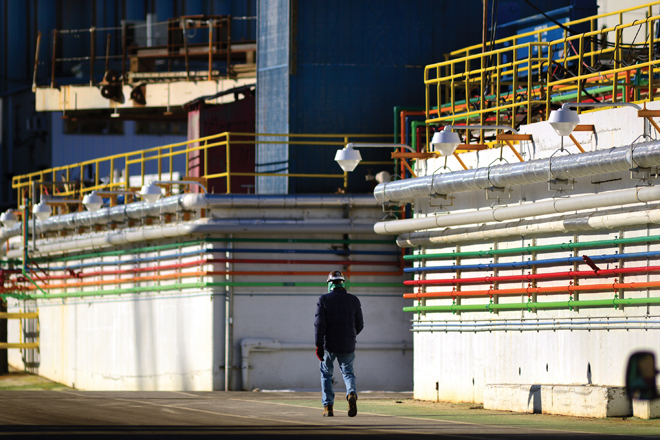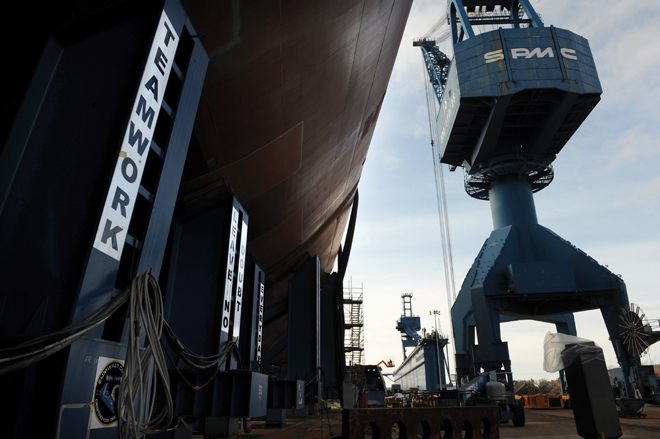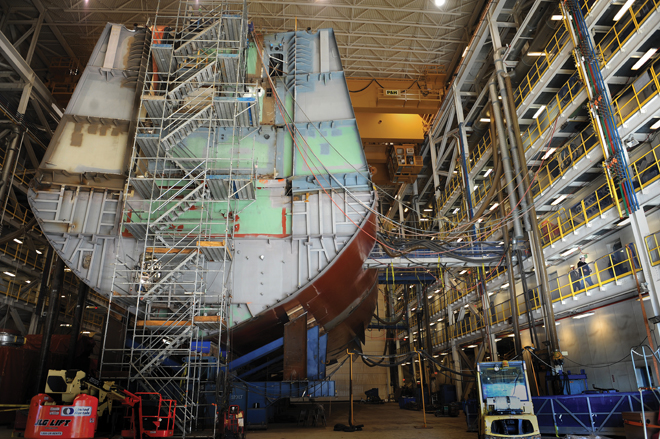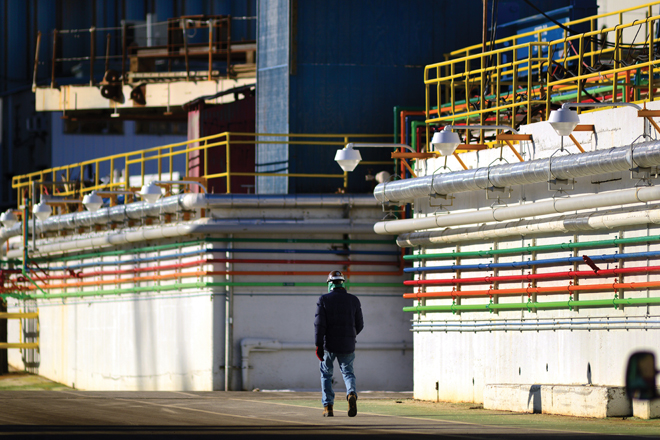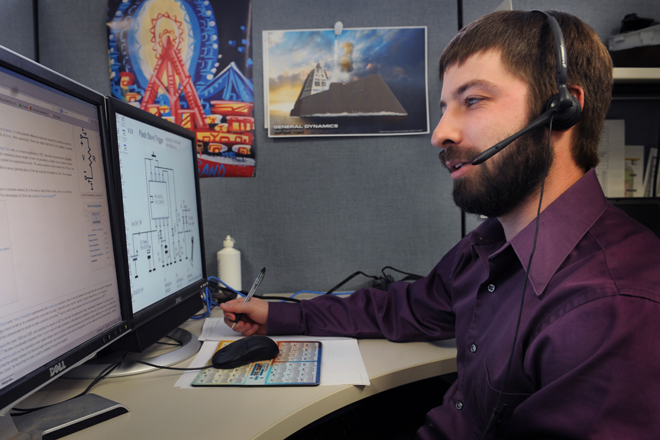The Yard
FEATURE-May 2013
By Jaed Coffin
Photographs by Fred Field
Driving north to anywhere on Route 1, you cant miss the orange and white boom of Crane 11 rising over Maines City of Ships like a sentinel from another planet.
The body is adorned with three capital letters: BIW. As a boy I gazed up at that crane at night from the backseat of my mother’s car while driving across the bridge over the Kennebec: its lights twinkling like a constellation of earthbound stars, its hook reaching into the cityscape of pale blue and gray buildings below, me imagining that whole armies of Transformer-like robots were being built within those secret walls, to protect our planet from evil Decepticons. This was back in the Cold War 80s; who knows where I got those ideas.
This March afternoon, as I’m driving down Washington Street along the shipyard’s tall green walls, past the narrow gates and small neighborhoods of sandwich shops and restaurantsSouthgate Diner, the Cabinand past a series of signs that read “Defense Contractor, No Photography,” there are other forces at work. On the news, there’s talk of sequestration, cuts in defense spendingforces that, in the business of shipbuilding, are as constant as the fierce tides of the Kennebec.
I park outside the main offices, meet with some PR folks, put on a helmet and steel-toed boots and goggles and earplugs, and enter the yard for the first time.
Massive machines move huge pieces of steel on greased tracks and trolleys, chains with links the size of a human being anchor various enormous things in place, men in work coats and helmets nod to each other without speaking as forklifts pass between them and weave their way through a glade of squat blue cranes. Behind a stack of steel beams, something that looks like a massive propeller shaft is waiting to be lifted in place. Everything here seems colored by a common dull hue and a palette of gray, rust, and the slate blue of the river beyond and the far bank and the winter sky. At the end of the yard is the body of the 660-foot Zumwalt (DDG-1000), the first battleship of its kind, suspended ten feet above the ground on jacks, surrounded by skeletons of staging, and tarps. Its bow is a new inverted design, meant to cut through the ocean rather than rise above it, and the ship itself looks like an enormous steel knife, or a maritime Millennium Falcon. There is no other shipyard on the planet building a Zumwalt. It has been in production at BIW for three years.
A stiff wind blows off the Kennebec. In many ways, the river has created all of this: for over 100 years, battleships and container ships and schooners and fishing boats and commercial vessels and barges and just about every other kind of floating thing have sailed these waters south to the Atlantic and onward into wars and fishing grounds and steamer routes, across oceans and canals and straits and passages. Bath Built is Best Built, the motto goes. The features of the Kennebec, uncommonly deep and generously broad, make it seem as if some midcoast god had forged the river with the lives of shipbuilders in mind.
Justin Dolan is a 31-year-old marine electrician. Slight, energetic, and articulate, he takes off a green safety helmet sporting a Red Sox B and a Patriots logo, pops out his earplugs and removes his glasses, and then tells me that he’s a fourth-generation BIW man. His mother and father, uncle, grandfather and grandmother, and great-grandfather all worked at the shipyard. “We’ve always been involved,” he says of his family. “It’s our way of life.” As a toddler, Dolan stood in the picket lines with his father during the labor union strikes of the 80s. After traveling around the country dabbling in various business ventures, Dolan came back home to enter an apprenticeship program taught in conjunction with Maine Maritime Academy. Dolan doesn’t see himself as merely an electrician. “Some days,” Dolan says, “I’m shootin’ studs, other days I’m welding. Everyone out here understands the work, what needs to get done. You learn one skill, and that leads to another skill. They’re all skills I can take outside the yard and put to use. And if there’s something at home that I don’t know how to do, there’s gonna be a guy in here who knows how to do it.”
Dolan takes enormous pride in his work. “To see hunks of steel turn into a destroyer makes you feel like you’re part of something, that you worked on something the Navy is going to use. Anyone in the Navy, you ask ’em who you want building their ships, they’re gonna say BIW.”
Now, Dolan lives 20 miles west in Lisbon Falls. He wanted to get a little distance from work, and from all his family in town. Every morning, he carpools into Bath with his wife and a friend; both ways, they talk about the shipyard. The same thing happens when he talks to his father on the phone. “One minute we’re talking about the weather, and then all of a sudden we’re talking about the yard. It’s hard to get away from it.” I ask him if he ever sees himself doing something different down the line. “I plan on being here. It’s part of my life,” he says. “Build ships, pay my bills, have some fun. Maine has its ups and downs, but this is where I want to be.”
Dolan then tells me about the other part of his life: his ten-month-old son. “I hope this place is still around when he’s my age,” Dolan says, “so he can have an opportunity to work here, too.” I ask Dolan what he means by opportunities and he tells me that a lot of his buddies who invested in four-year college educations are struggling to make 30 grand a year, while his work at BIW gives him a life he describes as “comfortable.” He shows up to work “ready for seven”; he clocks out at three-thirty. Dolan spends his free time hunting, fishing, camping, hanging out with his son and working on his house. I ask him what he thinks is the most important skill for a shipbuilder: “Pride in what you’re doing,” he says. “Some people try to skirt by in life, but if you have pride in yourself, you’re gonna do a good job.” The other virtue important in shipbuilding: “Patience. An ability to troubleshoot. You don’t want to get frustrated out here. If you do, just piece it out. It gets done.”
I was raised by guys like Dolan. They were the fathers of my buddies, the husbands of women who made our lunches, the men who disappeared at sunrise, entered the gates in the winter darkness and then came back to town in time to coach basketball practices at the Rec Center, to watch baseball games at Edwards Field, to sit down to dinners that their work at the yard had put on their tables. Sometimes these men came from awayVirginia, Louisiana, other yards across the countryand some of those families had to move to those other yards later in life. I can still remember the navy blue nylon jackets they used to wear: big collars, silver snap-buttons, the BIW flag on the chest, the mysterious sense of camaraderie between them founded on their shared construction of massive steel ships. And I remember the T-shirts their kids used to wear every time a ship was launched: black, their chests adorned with the images of Arleigh Burke destroyers and the pride that their fathers had built something that would never sink. Even if you knew the back roads, you couldn’t avoid the traffic jams on Route 1 between Bath and the highway when the afternoon shift got out at 3:30.
As Maine industry has evolved out of its historical past of fishing and farming and forests, so has the yard. Long ago, the ships were made of wood; now, it’s four-inch thick welded steel. For many decades, the yard dealt with a mix of commercial and federal customers; now BIW only builds for the Navy. The ownership has changed hands dozens of times, from the first generation under Thomas Hyde and his sons to the most recent umbrella of General Dynamics. But the shipyardthe second biggest employer in the statehas endured in a way that few industries in Maine have.
Chris Ouellette is not exactly the kind of young man who might line up with your image of a shipbuilder from the old days. His desk is upstairs in the design building, and he spends most of his day on a computer. He meets me in a conference room with a whiteboard on the far wall littered with diagrams and acronyms and arrows and lines that I can’t begin to follow. Ouellette has the quiet temperament of someone whose mind works in virtual spaces. His only safety equipment is the nametag hanging from his necksecurity clearance. From Harpswell, a graduate of Mt. Ararat High School, and the son of a parts manager at a car dealership, Ouellette never dreamed of being an engineer. He’s not handy at home (“tried to build a deck once, total disaster”), but he does know how to interface programming software with all of the Zumwalt’s profoundly complex operating systems. “I was always tearing crap apart,” he says. As a teenager, Ouellette built a computer. He was part of the Science Olympiad. He used to design his own websites “back when you actually had to write out your own code.” He didn’t “even know what an engineer was in high school.” After graduating with a bachelor of science in engineering and management and then receiving his master of business administration from Clarkson University, he underwent extensive interviews with Apple and IBM en route to landing a technology job. Then while he was home in Maine, he ran into a buddy’s father who was an engineer at the yard, and who suggested he apply for a new position at BIW. The government had just awarded the yard several new contracts; there was lots of work. Moving back to Harpswell, living with his parents, working at the shipyard”It wasn’t exactly what I had in mind,” Ouellette says. He’d imagined himself living in a city, andflipping to a page in the Press Herald and pointing to a random electronic device”thinking up stuff like this, for Apple.” But Ouellette had loans due and he wasn’t sure what was next. “Engineers,” Ouellette tells me, “don’t do well without a plan.”
Ouellette is a different breed of Maine shipbuilder: he’s “never dug clams, never been on a lobster boat” and doesn’t own his own boat; the welders who build the ships that he designs “blow his mind.” He doesn’t wear his BIW employment “like a badge;” he doesn’t see himself as a “shipbuilder.” What binds people like Ouellette and Dolan is their shared sense of work. “It’s got to be right,” Ouellette says. “That’s the culture of BIW, the culture I came into. Engineers, we have problems with gray area. It’s either right or wrong. The concept of making something right is what drives me.”
“My job is to make sure everything is working properly,” Ouellette tells me. “It can’t be subpar, it has to be done in the BIW way.” Ouellette has been working at BIW since 2007, and he’s yet to see his first ship come to completion. “It’ll be really amazing to see something I’ve been working on for the last five years that started out, essentially, as pieces of metal.” When I ask him about the Zumwalt, his eyes light up. “I feel like there’s so much more potential for us to keep making better ships. We’ve learned so much already.”
Back outside, I meet with Larry Buckowsky, the foreman in charge of the 500 welders who weld the steel hunks of the Zumwalt to each other. I should confess: I’ve known Larry since I was eight years old. His son and I are old buddies, and when we were boys pretending to be Navy SEALs in the woods behind his house, Larry rebuilt cars, or furnaces, or tuned up our bicycles, or did anything else that seemed technically mindboggling with whistling Sunday ease. I once crashed my old Volvo into the bumper of a Jeep full of cheerleaders. Larry rebuilt the front end at no charge. And yet growing up, I never knew much about what Larry did when he left the house at four in the morning, or when he went south for days at a time to oversee the sea trials for one of his ships.
Larry moves fast. He takes me on a speedy tour of every building in the 55-acre shipyard, explaining that the construction of ships is like putting together “big Lego blocks.” In every room we pass throughafter seeing a dozen or so, I’ve lost track of where we’re going and where we’ve beenmen and women are working behind torches, at odd angles, manufacturing parts at massive spinning machines, tinkering at smaller ones, fabricating a symphony of things that will soon go out to sea. Larry stops on the bridge of a three-story-high hangar, where pieces of a Zumwalt hull are turned upside down, outfitted with pipes and steel frames, then flipped over, sandblasted and painted in another part of the yard, lifted into place, welded to other pieces like it, every aperture connection fit to its brother in 100-percent alignment.
A graduate of Kings Point Merchant Marine Academy, Larry grew up working in the steel mills of Lyndora, Pennsylvania, often taking the hardest jobs available to get paid an extra quarter per hour for every story that he was willing to work above the ground. He started his career down the coast at Electric Boat, working on nuclear subs. Following the Cold War, Larry took his trade to Bath. At the time, BIW was starting its Arleigh Burke class of destroyersLarry says they’re currently in production on numbers 34 and 35. Larry came north for the spring while his wife and two toddlers finished the school year. He lived in a “flophouse” in Brunswick where he slept a few hours a night, but otherwise got to the yard at 4 a.m. “just to learn it.” Back then there were 800 welders on site, 12,000 employees. “It can take a few months before you get used to the shipyard nomenclature. It’s not like construction. The stakes are very high. If you got a ship out in the middle of the north Atlantic, you can’t just call a plumber.” But what Larry saw at BIW was something he’d never seen “down south.” “It’s the quality of the work,” Larry says. “You go other places, you can tell it isn’t the same. There are real craftsmen here. This is part of their heritage. Fathers and sons, a stewardship of people passing down skills from one generation to the next.”
Larry takes me under the hull of the Zumwalt. “Keep your helmet on,” he jokes. Then he takes me to the dry dock, where in September the Zumwalt will be trolleyed into the river for trials. I ask him how that feels. Unlike the younger generation of shipbuilders like Ouellette and Dolan, Larry’s seen dozens and dozens of his ships sail down the Kennebec. “There’s some big satisfaction. Someone’s gonna rely on that ship. This isn’t building widgets. We’re not pushing keyboards out here, we’re pushing steel.”
But then I remember watching Larry rebuild cars in his garage on his days off, and I ask him if he thinks of his work at the yard as hard. “This isn’t a job,” he says just as the riggers are lifting the enormous prop shaft of the Zumwalt into place. “It’s my hobby.”


